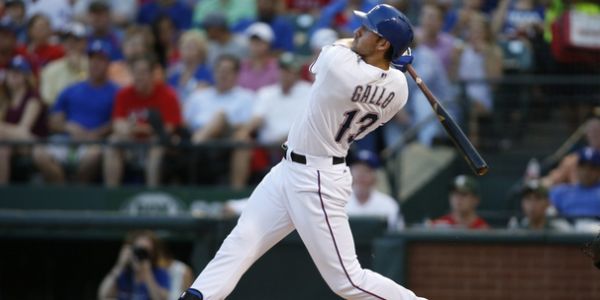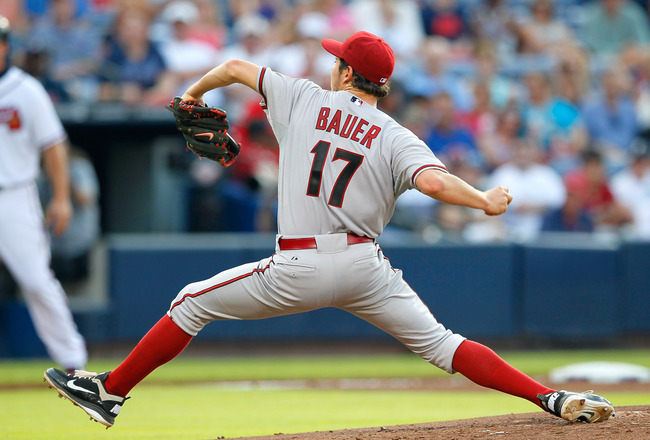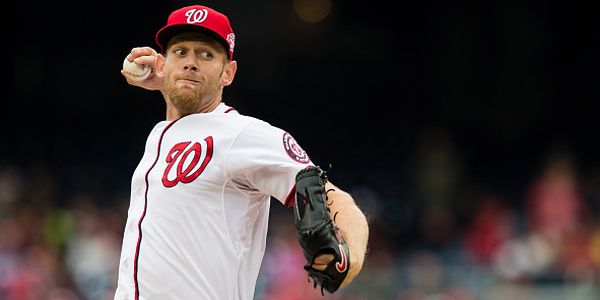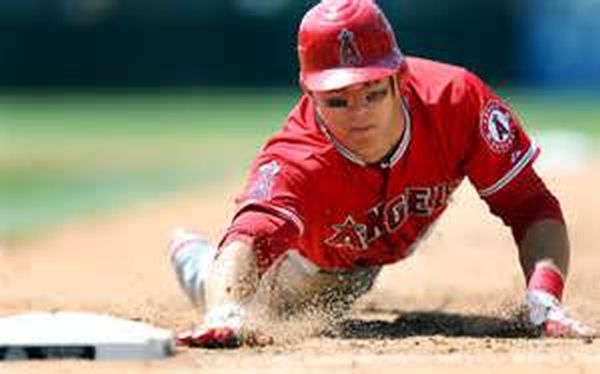Using ERA-FIP To Identify Starting Pitchers to Acquire or Trade
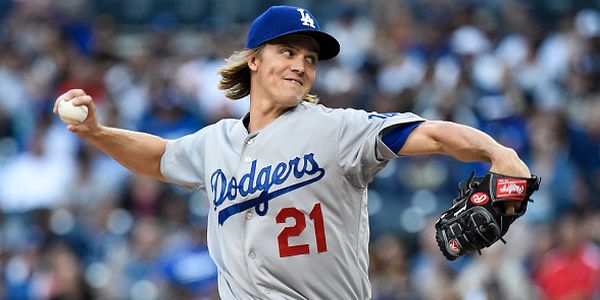
In this piece, I’ll be looking at one of my favorite strategies to identify starting pitchers to target via trade for fantasy baseball players in 2016.
Each and every baseball site you visit can probably provide you with a strategy to identify players to target via trade. One of my favorite statistics to look at for pitchers is ERA-FIP on FanGraphs. ERA-FIP provides users with the difference between a starting pitchers current earned run average and their fielding independent pitching. According to FanGraphs, Fielding Independent Pitching “measures what a player’s ERA should have looked like over a given time period, assuming that performance on balls in play and timing were league average.” Moreover, FanGraphs suggests that “FIP does a better job at predicting the future than measuring the present, as there can be a lot of fluctuation in small samples.”
The idea here is to look for pitchers who appear to be performing better than their ERA leads us to believe. These may be players that haven’t been so “lucky” to start the season, but theoretically should regress to the mean and improve as the season wears on. In addition to looking for players with the higher ERA-FIPs, I’ll take a look at the BABIP, LOB%, K%, BB%, SwStr% and SIERA to guide my search.
Below is the chart, but you can also download it directly here. Using FanGraphs general guidelines, I’ve used the color green to indicate average or better and red to display below average or worse. I’m focusing on the ERA-FIP (E-F) column to base my decisions, but will use all data to support my decisions. Data as of Monday, May 9, 2016.
Arms to Target
David Price | Red Sox – Price calls a new ballpark home, but is still locked into the AL East — a concern for some in the fake baseball world due to the plethora of heavy bats he’ll face throughout the year. There’s green across the board for Price all the way from his K-BB% to his FIP and over to the SIERA — all a good sign. He’s been BABIP’d around (.373) and has been bit by the HR/FB (11.8%) more than his career rate (9%), so there’s some that would say “a few bounces should be coming his way soon” or “the wind will keep in a few of the homers going forward.” And that could very well be true.
But looking a bit further, we can see that the velocity on each of Price’s offerings is down a couple of ticks with the biggest declines coming on his fastball and cutter. It’s still early in the season, so maybe he’s still ramping up a bit. Last year it took a month or two for his velocity to peak, so there’s a reasonable chance that it could do so again.
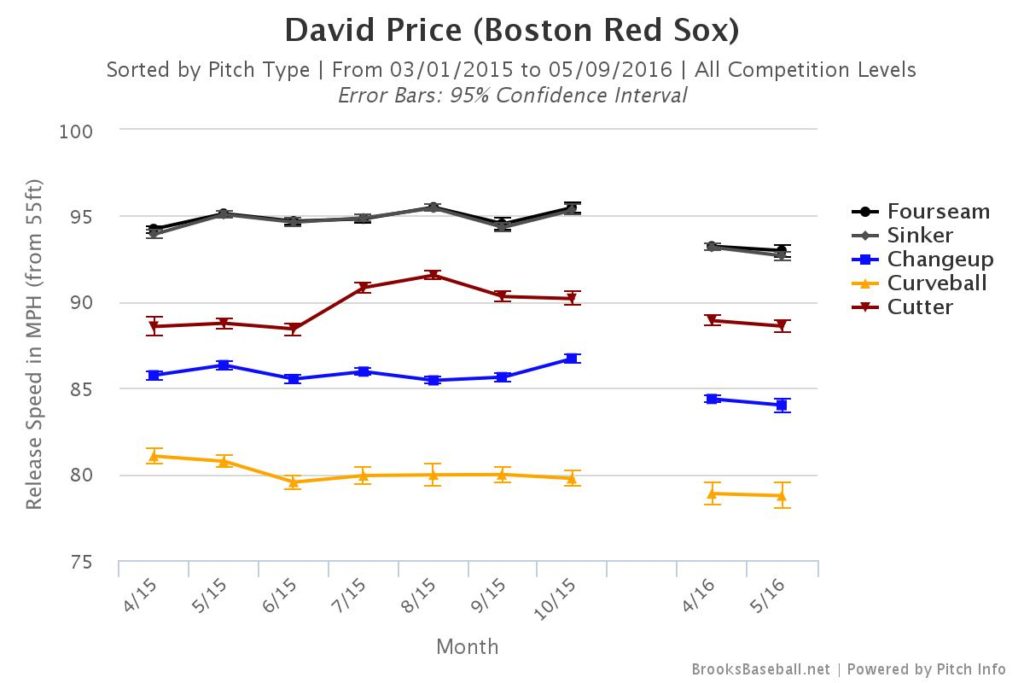
In addition to the dip in velocity, the southpaw is surrendering the second-most hard contact (41.2% Hard%) on balls in play in baseball among qualified starters, behind only Chris Archer of the Rays (41.4% Hard%). This is a concern because Price hasn’t allowed a Hard% higher than 28.6% (2013) over the course career and averages just 27.1% on average since 2008.
All things considered, I’d be trying to pry the former Cy Young award winner from their current owners. According to our trade chart, Price is still the sixth-most expensive pitcher out there, so you may have to pay close to full price. But maybe there’s an owner out there that is growing impatient with their ratios and doesn’t want to wait around for them to normalize.
Zack Greinke – Diamondbacks – Like Price, Greinke found himself a new home this offseason and struggled to start the year. Two games with seven earned runs is a recipe for the inflated earned run average, but that doesn’t exactly jive with his FIP or SIERA so theoretically the performances should have taken a turn for the better. He’s recently rebounded with two consecutive outings of eight strikeouts and just two earned runs allowed — a promising sign. The velocity on Greinke’s slider seems to be down a tick from ‘15 but compared to his career average this shouldn’t be a cause for concern. A 12% SwStr% leads us to believe his K% could spike a bit closer to the 23.7% he posted last season while he’s limited free passes to just 4.7% of opposing batters which ties a career best.
When looking pitch and plate discipline data there is a lot to like from Zack Greinke going forward. Put some feelers out there.
Ricky Nolasco | Twins & Jerad Eickhoff | Phillies – Between Nolasco and Eickhoff you have two arms that are going to be owned in your deeper leagues, but for those in shallow leagues you may be able to pluck off the waiver wire. In the deeper leagues, these may be easier targets to trade for as owners may be less attached to since they likely didn’t invest as much in these assets.
In Nolasco we may not see as much of an improvement in the ERA as we should see from Price or Greinke, but our ERA-FIP data suggest we could still see the right-hander cut more than a run off and land towards the 3.39 number that both FIP and SIERA agree he should be at. His K-BB% isn’t exactly flashy, but he’s better than average in both strikeouts and limiting walks (3.2% BB%). The use of the slider has spiked and he’s using it more effectively — inducing whiffs on over 16% of sliders and striking out 15 batters on that pitch. I really like how efficient Nolasco has been to start the year and think he’d be a fine addition to your staff and could come relatively inexpensive.
The 1-4 record and 4+ ERA may be the reason you could make a play for Phillies’ right-hander Jared Eickhoff. Both FIP and SIERA feel Eickhoff should be a 3.3-3.45 ERA type of pitcher, meaning lots of nice starts could be in his future. Eickhoff strikes out more than 20% of batters and fails to surrender a ton of free passes, keeping his K-BB% at an above average 17.9% rate. I always like targeting guys in the National League East so consider Jared Eickhoff if you need to add an arm.
Arms to Deal
Felix Hernandez | Mariners – King Felix was just dealt in Mixed LABR for Jeurys Familia. Jake Ciely probably saw some of what we’re looking at above when making the deal for Familia, in addition to the fact that he had an obvious need for saves. Hernandez’s velocity is down a couple of ticks on each of his offerings, his strikeouts are down, walks are way up and opposing hitters are making more contact on his pitches both in (90.4 Z-Contact%) and out (64.3% O-Contact%) of the zone. Lots of literature going around about selling his shares right now, so I don’t think you’ll get full return on your investment — even on name value — but it’s worth floating his name to see how you can help your team in other ways.
James Shields | Padres & Mat Latos | White Sox – Mat Latos hasn’t been a good pitcher for some time now and I the metrics believe he’s still not all that good. He is maintaining an above average walk rate (7%), but his strikeout rate, K-BB% and SwStr% are all below average. FIP (4.44) and SIERA (4.9) think his pretty 2.62 ERA could fall off a cliff soon. Shields owns an above average SwStr% so his K% could improve and he hasn’t been as lucky as some of the others on this list in terms of BABIP and LOB%, so although I am willing to deal the Padres’ right-hander, I’d want to get close to full price for him.
Martin Perez | Rangers & Brandon Finnegan | Reds – Seeing lots of red with this duo outside of the ERA column. Consider those red flags! Get it? They’re not striking out enough batters, they’re walking too many and they’ve been pretty “lucky” as some would say according to batting average on balls in play (BABIP) and strand rate (LOB%). FIP and SIERA think these arms will finish with an ERA in the high 4’s or 5’s. See what you can get for them while they still have value if you believe in these types of metrics.


